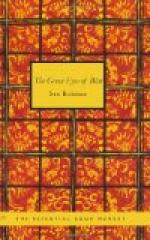“In that room where supper was laid for two?” I muttered.
“Can you doubt it?”
“No,” I said, “and I don’t.”
“I have allowed nothing to be touched,” continued Gatton, “and I am going around there now to make a final attempt to unravel the mystery of how Sir Marcus met his death.”
“There is one detail,” said I, “which it seems impossible to fit into its proper place in the scheme. The figure of Bast painted upon the crate—you have that at Scotland Yard—and the little image of the goddess which was stolen from my table last night.”
Gatton stood up, uttering a sigh.
“I have always found, Mr. Addison,” he replied, “that it is these outstanding features of a case, these pieces which don’t seem to fit, that are the most valuable clews. It’s the apparently simple cases in which there is no outstanding point that are the most baffling.”
I laughed shortly.
“One could not very well complain of the lack of such features in ’the Oritoga mystery,’” I said. “As a confrere of mine remarked when the body of Sir Marcus was discovered in the crate, the whole thing is as mad as ’Alice in Wonderland’!”
Gatton presently departed for the Red House and I accompanied him, for I was intensely curious to learn by what means the murder of Sir Marcus had been accomplished. As I proposed later in the morning to call on Isobel, Coates drove Gatton and myself as far as the Red House and I instructed the man to wait for me.
Although the morning was still young, the prominence given by the press to this sensational crime had resulted in the presence of quite a considerable group of pilgrims who even thus early had arrived to look upon the scene of the mysterious tragedy. London is a city of onlookers. The most trivial street accident never lacks its interested audience, and a house in which a murder is reputed to have taken place becomes a center upon which the idly curious focus from the four points of the compass.
Our arrival created a subdued excitement amongst the nondescript group gathered upon the pavement. Despite the efforts of a constable on duty, men, women and children persistently gathered before the gates of the drive peering up at the empty house as if they anticipated seeing the face of the murderer or an apparition of the victim appear behind one of the windows. A considerable group, too, was gathered before the garage, but as Gatton and I descended and began to walk up the drive there was a general movement in our direction.
“I wonder,” said I, “if ‘A,’ the wanted man, is among the crowd? One reads that murderers are irresistibly drawn back to the scene of their crimes.”
“He may be,” replied Gatton; “anyway there are two C.I.D. men there for certain, so that ‘A’ will do well to be upon his guard.”




